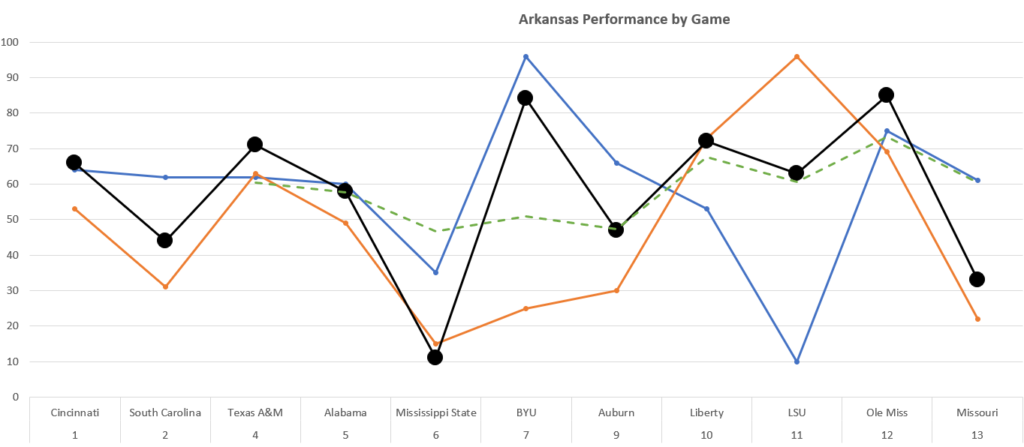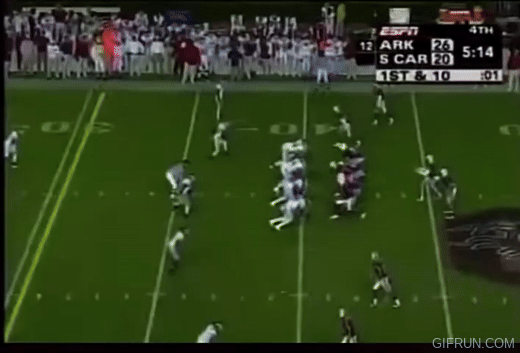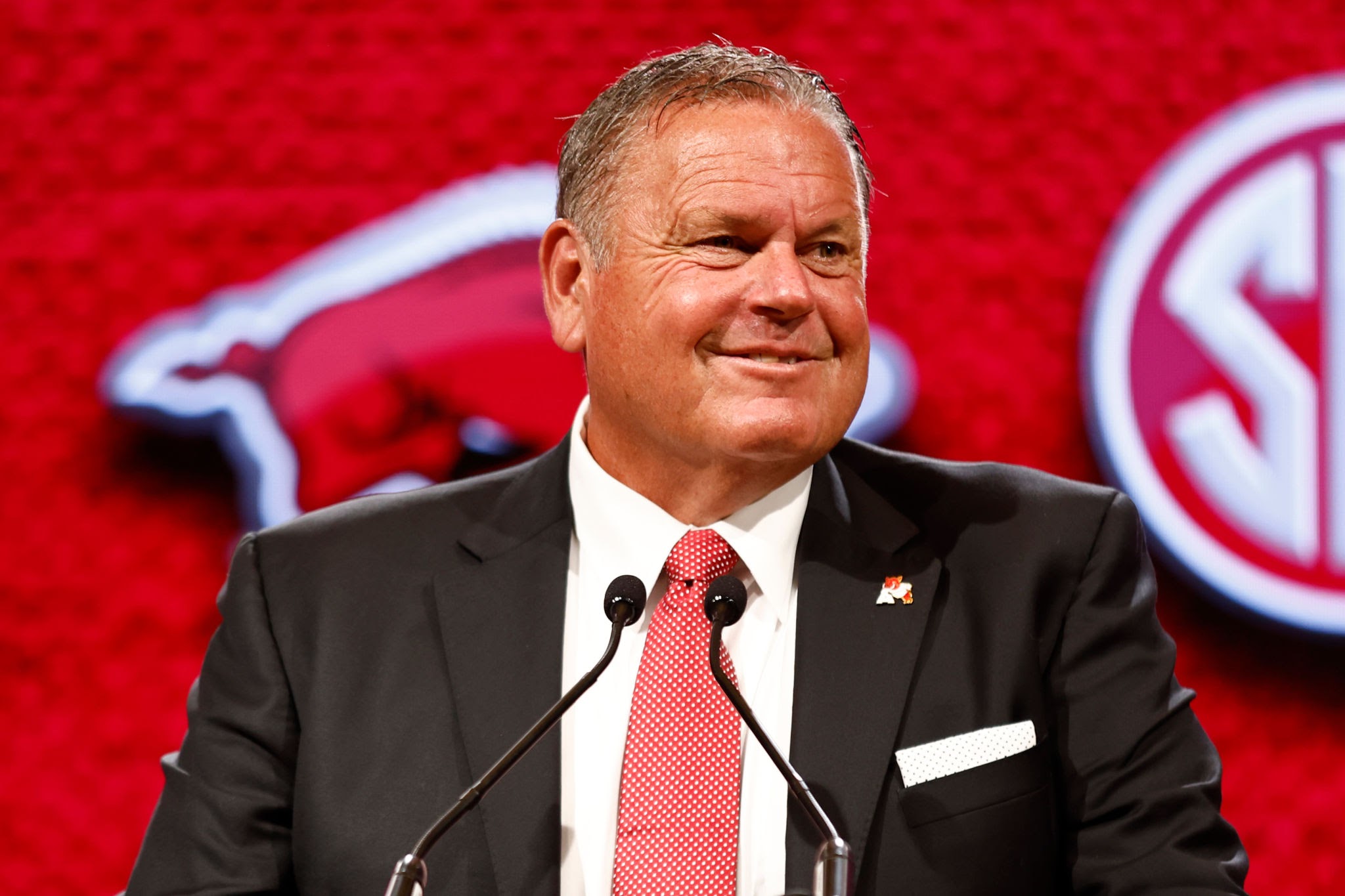Razorback football returns this week. After starting hot against Cincinnati and South Carolina last year, the Hogs are slow-walking their way into this season, opening with Western Carolina, Kent State, and BYU, all at home.
There’s no point in previewing this game in depth – it’s an FCS opponent, and our models don’t track team averages for FCS teams – but this post will highlight what to watch for this season, starting with the first game.
This is year we learn how good Sam Pittman is
Chad Morris devastated the program on the field and in the eyes of the college football world, but he did recruit pretty well. And Sam Pittman was the right man at the right time to take Morris’s accumulation of talent and turn it into a winning program very quickly.
But is he still the right man, and is this still his time? Does the right man lose to Liberty and trail Missouri State by 10 points in the fourth quarter during his third year? This is the year that we find out whether Pittman was just the brief savior of the program, or a really good coach capable of taking the Hogs to the next level as a program. If Arkansas goes 6-6 or 7-5 this year, then it’s fair to call Pittman a football version of Mike Anderson, and Hunter Yurachek may need to start thinking about who his Eric Musselman is.
With two new coordinators and just eight returning starters on both sides of the ball, Pittman isn’t making it easy. Almost all of Morris’s recruits are gone; this is now his team and his hires. Recruiting is going really well and total team depth is easily the best its been under Pittman, but the Hogs cannot waste KJ Jefferson’s last year. The set-up is there for long-term success, but the breakthrough has to come now.
Western Carolina isn’t going to answer many questions, but here’s what I’ll be watching for.
Will Dan Enos’s offense generate enough explosive plays?
Kendal Briles is out after three years as Arkansas’ offensive coordinator. Briles’s Razorback offenses put up big numbers, but the former Baylor OC was never overly popular with the fans because of his last name and his flirtations with other schools. To replace him, Pittman brough back Dan Enos, the Hog OC under Bret Bielema from 2015 to 2017.
Enos is going to be quite different from Briles. He’s gone more shotgun and embraced RPOs since his first stint in Fayetteville, but he’s still a clock-churning, balanced, West Coast guy in terms of offense. The Hogs will throw a lot more on early downs, mostly short and safe passes, and will use a ton of play action. The tight ends will be very active. The Hogs will control the clock and field position much more effectively. The main cost will be in terms of explosive plays, which will likely be much fewer.
There are three factors to keep an eye on this season with the transition:
- Enos’s offense will generate fewer explosive plays, which will leave the Hog offenses with a much smaller margin for error. That’s concerning if you don’t have a clear talent advantage.
- Despite an analytically-correct focus on explosive plays, Briles’s 2022 offense was plagued by negative plays. Enos’s scheme will likely be much more efficient and conservative. Will that cancel out the explosive plays concerns?
- There are some schematic reasons to be worried that KJ Jefferson and Rocket Sanders were uniquely suited to the Briles offense, and may even be due for a step back in Enos’s scheme. How does Enos get the most out of their skill set, and what’s Plan B if they struggle?
Can the Hogs survive on fewer explosive plays?
For Briles’ many faults, his offenses generated explosive plays, which say is key to lasting success, especially if you are wanting to pull some upsets. TCU, which just made a Cinderella run to the national title game on the back of big plays, understood that in hiring Briles. Enos’s offenses are generally not explosive. His 2022 Maryland offense ranked 113th out of 131 teams in explosive play rate (we define explosive plays as runs of 10+ and passes of 20+ yards). Instead, Enos prefers an efficient, balanced offenses that wins field position, eats the clock, doesn’t make mistakes, and keeps the chains moving.
There are some reasons to doubt that will work. We’re back to the “can you out-Alabama Alabama?” questions that plagued the Bielema era. Every SEC West school other than the Mississippis consistently recruit at a higher level than Arkansas, and Enos is establishing a scheme with a low margin for error and a disadvantage in raw talent. That’s where the risk is.
Boom or bust under Briles
But although Briles’ scheme seemingly gave Arkansas a better chance to compete, Arkansas’ 2022 offense was flawed in a lot of ways. First, its boom-or-bust nature meant that the defense spent a lot of time on the field. We’ll discuss the defense below, but it already lacked depth and was ravaged by injuries all year. Enos’s slower ball-control offense will buy it some time and field position.
Second, Arkansas’ offense just wasn’t that good last year:

Obviously, the defense was the bigger problem, but just 45th in Offensive EPA per Drive? That’s pretty disappointing for a team with Arkansas’ offensive talent. Unsurprisingly, Arkansas’ two lowest-graded offensive performances were games that KJ Jefferson missed with injury (LSU and Mississippi State), but the Hogs sported just one game with an offensive grade (blue line) higher than 75:

The Hogs scored at a good rate and accumulated a lot of yards, so what went wrong?
See if you can figure it out:

Despite inheriting excellent field position (4th), being extremely efficient when falling behind the chains (8th), being very good at generating explosive plays (13th), and not being overly turnover-prone (48th) or bad in the red zone (27th, which might surprise some folks), the Hogs were just 31st in EPA / Play and 45th in EPA / Drive. And the problem, in its entirety, was negative plays, recorded as Havoc Rate (120th).
A “havoc” play is a run stuff, sack, pass breakup, interception, or forced fumble. Basically, anything the defense does to cause havoc. Interceptions and fumbles were not big problems for the Hogs, but run stuffs and sacks were. Some of the sacks were Jefferson’s fault for holding onto the ball for too long, but the run stuffs were a schematic issue:

These numbers are silly: the Hogs were 20th in efficiency, 9th in explosiveness… and just 48th in actual EPA per rush? That’s what negative runs can do to you. The Hogs didn’t have many “neutral” runs: they had a ton of successful runs, but the unsuccessful ones were often devastating.
So we’ve seen that the Briles offense was a mixed bag. The football “analytics revolution” claim that you should go all-in on explosive plays is just as complicated as the basketball claim that you should avoid midrange shots: on a high level, it’s true, but it’s very complicated to actually get there. In basketball, if you never shoot midrange, even when wide open, out of a commitment to this dogma, you probably aren’t helping yourself out. In the same way, the dogmatic pursuit of explosive plays leads to negative plays, which leads to quick three-and-outs, which leads to devastating field position swings and a tired defense.
Keep an eye on negative plays and three-and-outs under Enos’s offense.
Did Briles’s scheme prop up Jefferson and Sanders?
There is one more reason to be cautious about the transition from Briles to Enos, courtesy of our friend SEC Stat Cat. His site tracks subjective stats, and two stats in particular are a bit concerning for the Hogs.
First: KJ Jefferson ranked in the middle of the SEC in depth-adjusted accuracy. Accuracy is a subjective stat: someone has to grade every throw whether it was “accurate” or not. An accurate throw that is not caught or broken up is recorded as a “drop” against the receiver. There’s a raw Accuracy %, but because deeper throws have a lower baseline accuracy, we can just the Accuracy % for average depth of target to get Depth-Adjusted Accuracy %. Jefferson has been very accurate on deep throws in 2021 and 2022, but his mid- and short-range accuracy has been at or below SEC average both seasons. He’s been particularly bad at slants during his career.

So what’s the concern? Obviously, Jefferson offers skills as a runner, but getting solid passing stats out of an “average” passer is a function of a good scheme. Jefferson led the SEC in the percentage of passes that led to a first down or touchdown (called “1D+TD%”), so Briles called passes that put his quarterback in a position to succeed.
Arkansas got the biggest bang for its buck on deep throws, but Enos is likely going to call fewer deep throws than Briles did, as his West Coast style of offense is more horizontal than vertical. If Jefferson’s more mediocre underneath passing is brought to the forefront, it could theoretically get exposed. Now to be fair, Brandon Allen took a major step forward under Enos’s coaching in 2015, so it is entirely possible that Jefferson also takes a big step forward in his short- and mid-range accuracy in 2023. If not, Enos will have some tough playcalling decisions to make.
Second: Rocket Sanders was elite before contact, not after. We can split runs into “yards before contact” and “yards after contact”. Before contact is generally a function of scheme and offensive line skill, not running back skill. Good schemes will create big holes for runners, and good linemen will block open holes. Yards after the initial contact is all on the back. To be fair, running back skill is still somewhat relevant before: vision and breakaway speed can boost yards before contact.
Sanders led the SEC in yards before contact by a mile, at 3.47 YBC per rush. But after contact? Not so hot:

Sanders was the only starting-level rusher in the SEC last season to get more than half his yards before contact. His 3.03 YAC per rush ranked 12th out of 14 starting SEC running backs, ahead of only the backs from Vanderbilt and Mississippi State.
As with Jefferson’s accuracy, this suggests that Arkansas’ scheme was really good for Sanders to be that productive while creating that few yards after contact. The Hogs spread opponents out, used Jefferson as a run threat, and had a variety of run concepts to use. Having an above-average run-blocking line also played a role.
Will Enos produce similar stats in his offense? We don’t have YBC/YAC data back to Enos’s first stint as Hog OC, but we do generally know that West Coast-style offenses generally prefer tough runners and YAC to one-cut homerun hitters and YBC. In 2018, when Enos was Alabama’s co-OC, the Tide backs were just middle of the SEC pack in YBC, but Najee Harris led the conference in YAC. Meanwhile, Arkansas’ Rakeem Boyd led the SEC in YBC that year, running the Chad Morris offense that had some similarities to Briles’s, especially in run game design. Hog fans have probably noticed that Boyd and Sanders are very similar in running style.
I’ll be closely watching Arkansas’ run game to see if it can consistently produce holes for Sanders under Enos like it did for Briles. If it can’t, and Sanders’ lack of YAC drags down his numbers, then you could see a bigger role for a tough runner like Dominique Johnson, whose 4.0 YAC in 2021 easily paced the Hogs running backs.
How does the Hog defense manage the transition?
We’re also seeing big changes on defense, as Barry Odom is off to UNLV and Travis Williams and Marcus Woodson are in as co-DCs. The switch here is similar to offense, where a more unique, maximize-what-you-have style is being swapped for a more conventional style that will be more dependent on recruiting and development rather than schematic advantage.
Odom had success bothering inexperienced quarterbacks with his Dime packages, but “bothering bad QBs” isn’t good program-building, and his efforts to transition to a defensive look with four down linemen and more man didn’t work, though injuries played a major role.
I took a first look at the new scheme back when Williams was hired, but the gist of it is this: Williams comes from the Kevin Steele tree of the 4-3 Over. The Over is a classic, time-tested defense that has been the dominant look in the SEC for more than 20 years. Arkansas ran it as a base defense under Reggie Herring (DC 2005-2007). It relies on a very fast back end paired with a monster defensive line. Defensive linemen need to be both strong and quick to thrive, as they are asked to be major playmakers. The scheme is more about giving freedom to freak athletes, so it is typically simple.
There are two big questions here:
- Does Arkansas have the playmakers on the defensive line?
- Can the rebuilt secondary hold up?
Does the defensive line have enough playmakers?
A reference point for how this style of defense works for Hog fans is the 2006 defense, with its all-Little Rock defensive line of Jamaal Anderson, Antwain Robinson, Marcus Harrison, and Keith Jackson Jr. That defense featured an elite pass-rush and was also very active against the run, allowing the small, quick linebacking corps led by Sam Olajabutu to play sideline-to-sideline. That’s how this scheme ideally works.
The Hogs have Landon Jackson as a nice starting point. He has the potential to be a playmaker off the edge. But veterans like Jashaud Stewart and transfers like Trajan Jeffcoat have not been consistent playmakers throughout their careers. And the tackles, who under Odom were asked to be road-blockers to give the linebackers an opportunity to make a play, are now going to have to be more active. We haven’t seen overwhelming playmaking ability from guys like Cam Ball and Taurean Carter to this point in their careers. Does that change this season?
Can the Hogs’ rebuilt secondary hold up?
Odom signed transfers Jackson and Jordan Domineck up front and Dwight McGlothern in the secondary last year to help with the transition to a defense like this, but injuries in the secondary largely forced the Hogs to abandon it as a base defense. Outside of McGlothern, the Hogs just couldn’t hold up in the secondary, with even FCS Missouri State torching them.

The Hogs generated consistent pressure, but outside of Domineck, much of that pressure came when the Hogs blitzed, which left them vulnerable to big plays when the pressure didn’t get home.
In the ideal world of the 4-3 Over, blitzing is rarely needed, because the four-man rush arrives. The back seven can play man-heavy where the goal is just to hold up until the pressure gets to the passer. Herring’s Arkansas defenses were so man-heavy that when Herring switched to zone on the final drive of the 2006 South Carolina game and the Hogs clinging to a 26-20 lead, it fooled Steve Spurrier and the Gamecocks so thoroughly that they promptly threw an easy pick to Darius Vinnett to seal the win:

McGlothern is an elite trail man defender, but what about the rest of the secondary? Baylor transfers Al Walcott (safety) and Lorando “Snaxx” Johnson (nickel) are talented enough to be an immediate upgrade. Georgia transfer Jaheim Singletary, a former high-4-star recruit, seems to have the other cornerback spot nailed down with Quincy McAdoo out for the season. And veterans Hudson Clark and Jayden Johnson look to be battling for the final safety spot.
On paper, this is a significantly better secondary than last year. Time will tell if it can hold up against the rigors of an SEC schedule. Because of its lack of schematic craftiness, long-term success will heavily depend on recruiting and development. The new defensive staff is off to a blazing start on the recruiting trail, so even a modest step forward on the field this year will create plenty of positivity.
Keys to the Game
- Don’t get hurt. Avoiding injuries is always the biggest key in an FCS game.
- Build some rapport in the passing game. I expect the Hogs to come out throwing, letting Jefferson get some live work with his new targets while the game is still in the balance. That might make the Little Rock crowd slightly restless if it’s not perfectly crisp, since riding Rocket for 25 carries probably leads to a more comfortable win.
- See what the secondary can do. In the Missouri State game last year, Odom had to dump his vanilla gameplan and blitz Petrino’s offense into turf. That’s not ideal for an FCS opponent, but the alternative there was defeat. I expect the Hogs to be very basic for this one as well. The Catamounts will likely have an above-average FCS offense, so don’t be surprised if they move the ball a bit. If they’re scoring at will, then you can panic.
Thanks for reading! Be sure to follow us on Twitter and on Facebook.
The latest from Fayette Villains, straight to your inbox
Enter your email to subscribe and receive new post alerts and other updates. You can unsubscribe at any time.
